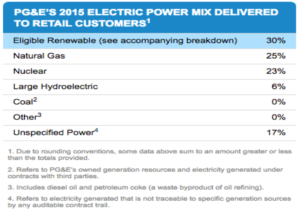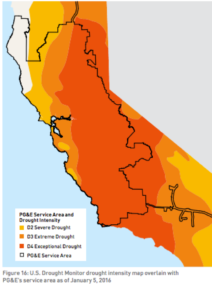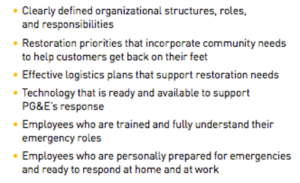Pacific Gas and Electric: Searching for a Renewable Energy Future

California based Pacific Gas and Electric leading the way to supply sustainable electricity and reduce its carbon footprint
Is it possible for a natural gas and electric utility to be a leader in the fight against climate change? It seems illogical when heat and electric energy production contributes to 25% of global green house gas emissions each year.[1] But just because an industry is defined by its history of burning fossil fuels to create energy does not mean that all companies engaged in the same practice are evil. A company on the forefront of limiting their own carbon emissions, searching for sustainable alternatives, and changing their operations to better combat adverse climate events in the future can actually be a force for good.

Pacific Gas & Electric (PG&E) is a California based electric utility that recognized early on that world would need innovative solutions to combat climate change and the effects of global warming. PG&E produces more than 30% of its energy from its Renewable Energy Portfolio and is one of the cleanest energy companies in the United States.[2]
Renewable energy is not new for PG&E who has been at the forefront of combating climate change in electrical power generation for over a decade. In 2006 PG&E issued a commitment to be an industry leader in lowering their greenhouse gas emissions and searching for clean energy alternatives. PG&E implemented policies and programs in conjunction government partners to address climate change.[3] In 2009 when the US Chamber of Commerce opposed the American Clean Energy and Environment Act (Waxman Markey) PG&E decided to leave the organization. PG&E vocally opposed how the organization did not recognize the existence of global warming.[4] CEO and Chairman of the Board at the time Thomas Donohue wrote that “climate change is the most important issue to our company, our country, and the world.”[5]
Beyond simply acting a supplier of renewable energy PG&E has changed its standard operating procedures to reduce its carbon footprint. The new strategy focused on decreasing energy use in its facilities, lowering methane and other emissions in its operations, investing in low emission vehicles, and building a more sustainable supply chain.[6]

Although PG&E remains committed to renewable energy sources their business is continually at risk from the threats of climate change. Extreme weather events often impact operations causing emergency responses and repairs that increase the cost of delivering power to customers. In the northern and central California weather like droughts and wildfires cause supply disruptions that negatively impact profitability.[7] Rising daytime maximum and nighttime minimum temperatures cause unanticipated stress on their grid and decrease the expected useful lives of their assets.[8]
Management has responded by outlining detailed policies and procedures to help mitigate and combat these risks. PG&E responded with operational, technological, and logistical systems improvements in 2013 as part of their Emergency Management Advancement Program.

PG&E hopes that external engagement and scientific research will help the company address climate change impacts in the future. The company actively seeks out partners in local, state, and federal government to work together setting long tern sustainability goals. They are currently working with California’s state government through Assembly Bill 32 to reduce State GHG emissions to 1990 levels by 2020.[9] Also, the company is worked with the California state government to achieve a 20% renewables portfolio by 2016 and currently is well ahead of schedule at almost 30% and ahead schedule to achieve 33% by 2020.[10] PG&E employs a five member in house climate change team to monitor their progress and stay on top of the latest global warming trends.[11]
But are they doing enough to combat climate change?
Despite their efforts to contribute to a more sustainable future PG&E continues to operate three natural-gas-fired plants. In order to be truly sustainable they should consider exiting this business and aim to provide fossil fuel free electric power to customers. Right now, PG&E should actively prioritize achieving this goal while looking to further reduce their carbon footprint from operations. It would send a clear message to others in the industry that PG&E stands by its belief in renewable energy sources and a future of US energy production not dependent on fossil fuels. In an industry where carbon emissions are part of the standard operating procedure PG&E is a model for other companies to follow. PG&E still has a long way to go but are on the right track to being able to one day provide 100% renewable energy to customers.
(730 words)
[1] Rebecca Henderson, Sophus Reinert, Polina Dekhtya, and Amram Migdal, “Climate Change in 2016: Implicatoins for Business,” HBS No.2-317-032 (Boston: Harvard Business School Publishing, 2016), p. 2.
[2]Pacific Gas and Electric Company, “PG&E Achieves Major Renewable Energy Milestone,” February 25, 2016, https://www.pge.com/en/about/newsroom/newsdetails/index.page?title=20160225_pge_achieves_major_renewable_energy_milestone_and_remains_a_national_leader_in_greenhouse_gas_reduction_ accessed November 2016
[3] Pacific Gas and Electric Company, “Climate Change Policy Framework,” http://www.pge.com/includes/docs/pdfs/about/environment/pge_climate_change_policy_framework.pdf, accessed November 2016
[4] Schendler, Auden and Michael Toffel, “Where Green Corporate Ratings Fail.” Working Knowledge: Thinking That Leads, January 6, 2012, http://hbswk.hbs.edu/item/where-green-corporate-ratings-fail, accessed November 2016
[5] Donohue, Thomas, “Letter to US Chamber of Commerce,” http://www.c2es.org/docUploads/PGE-letter-to-chamber-09-18-09.pdf
[6] Pacific Gas and Electric Company, “Clean Energy,” http://www.pgecorp.com/corp_responsibility/reports/2016/bu06_clean_energy.jsp accessed November 2016
[7] Pacific Gas and Electric Company, “Climate Change Vulnerability Assessment” http://www.pgecurrents.com/wp-content/uploads/2016/02/PGE_climate_resilience.pdf accessed November 2016
[8] Pacific Gas and Electric Company, “Climate Change Vulnerability Assessment” http://www.pgecurrents.com/wp-content/uploads/2016/02/PGE_climate_resilience.pdf accessed November 2016
[9] “California Assembly Bill 32,” California EPA Air Resources Board, https://www.arb.ca.gov/cc/ab32/ab32.htm accessed November 2016
[10] Bebon, Joseph, “PG&E ‘Far Surpassed’ State Renewable Energy Goal,” SolarIndustryMag.com February 26, 2016 http://solarindustrymag.com/pge-far-surpassed-state-renewable-energy-goal/ accessed November 2016
[11] Pacific Gas and Electric Company, “Climate Resilience” http://www.pgecurrents.com/wpcontent/uploads/2016/02/PGE_climate_resilience.pdf accessed November 2016
Exhibit 1: http://www.pgecorp.com/corp_responsibility/reports/2016/bu06_clean_energy.jsp
Exhibit 2: http://www.pgecurrents.com/wpcontent/uploads/2016/02/PGE_climate_resilience.pdf
Exhibit 3: http://www.pgecurrents.com/wpcontent/uploads/2016/02/PGE_climate_resilience.pdf



Great post, Mark. I like how you’ve discussed a company that relates to climate change in it’s business model.
The solutions you’ve proposed are pretty radical and that’s why I like them but I wanted to ask you what you felt about a phased approach towards exiting the natural gas fired plants instead of immediately closing them down. Let’s grab coffee next week to discuss this more and the potential ramifications exiting this business might have on PG&E.